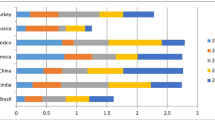Abstract
In recent years, European environmental policy has focused primarily on the reduction of carbon emissions and on fostering the expansion of renewable energy production. In 2008, the EU established the 20/20/20 vision, demanding that carbon emissions and energy consumption both be reduced by 20%, and that the production of Green Energy be further increased in order to account for 20 percent of total energy production by 2020. Regarding the reduction of emissions, a cap-and-trade system (Brown Certificates) was implemented. for the fostering of so called renewable, i.e. Green, energy different nations chose different measures, such as direct subsidies, feed-in-tariffs (e.g. Germany), or Green Certificate markets based on a quota system (e.g. Denmark). Recently, a market-based instrument (White Certificates) intended to improve efficiency of non-commercial energy consumption is also on the agenda of several European nations (demand side management). All of these instruments are directed towards the energy market. Therefore, this paper deals with identifying interdependencies and trade-offs that might occur, if both, supply and demand side, of a single market are regulated by different policy measures. Our results show that, in fact, significant interdependencies and trade-offs exist. In our model, a feed-in tariff in combination with an emission cap or tax renders the most favorable results—in the absence of demand side management.
Similar content being viewed by others
References
Amundsen ES, Mortensen JB (2001) The Danish green certificate system: some simple analytical results. Energy Econ 23: 489–509
Bertoldi P, Langniss O, Rezessy S, Voogt M (2005) White, green and brown certificates: how to make the most of them? ECEE 2005 Summer Study, panel 7 new economic instruments
Bertoldi P, Rezessy S (2008) Tradable white certificate schemes: fundamental concepts. Energy Effic 1: 237–255
Boehringer C, Rosendahl KES (2008) Green serves the dirtiest: on the interaction between black and green quotas. Discussion papers no. 581, April 2009 Statistics Norway, Research Department
Buerger V, Wiegmann K (2007) Energieeinsparquote und Weisse Zertifikate. Arbeitspapier, Oekoinstitut e.V., Freiburg/Darmstadt
Child R, Langniss O, Klink J, Gaudioso D (2008) Interactions of white certificates with other policy instruments in Europe. Energy Effic 1: 283–295
European Parliament, European Council (2009a) Directive 2009/125/EC establishing a framework for the setting of ecodesign requirements for energy-related products. Off J Eur Union. LN 285/10. http://eur-lex.europa.eu
European Parliament, European Council (2009b) Directive 2009/31/EC on the geological storage of carbon dioxide. Off J Eur Union. LN 140/114. http://eur-lex.europa.eu
European Parliament, European Council (2009c) Directive 2009/28/EC on the promotion of the use of energy from renewable sources. Off J Eur Union. LN 140/16. http://eur-lex.europa.eu
European Parliament, European Council (2010) Directive 2010/31/EU on the energy performance of buildings. Off J Eur Union. LN 153/13. http://eur-lex.europa.eu
Greening LA, Greene DL, Difiglio C (2000) Energy efficiency and consumption—the rebound effect—a survey. Energy Policy 28: 389–401
Khazzoom JD (1980) Economic implications of mandated efficiency standards for household appliences. Energy J 1: 21–39
Mundaca L, Neij L (2006) Tradeable white certificate schemes: what can we learn from early experiences in other countries? The International Institute for Industrial Environmental Economics, Lund University, Sweden
OECD: (2007) Instrument mixes for environmental policy. OECD Publishing, Paris
OECD (2011) Interactions between emission trading systems and other overlapping policy instruments. General distribution document, Environment Dirctorate, OECD, Paris. www.oecs.ord/env/taxes
Oiokonomou V, Jepma CJ (2007) A framework on interactions of climate and energy policy instruments. Springer Science+Business Media BV
Oiokonomou V et al (2008) White certificates for energy efficiency improvement with energy taxes: a theoretical economic model. Energy Econ. doi:10.1016/j.eneco.2008.04.005
Orasch W, Wirl F (1997) Tehnological efficiency and the demand for energy (road transport). Energy Policy 25: 1129–1136
Patterson MG (1996) What is energy efficiency? Concepts, indicators and methodological issues. Energy Policy 24(5): 377–390
Pavan M (2008) Tradable energy efficiency certificates: the Italian experience. Energy Effic 1: 257–266
Roca J, Alcantara V (2001) Energy intensity, CO2 emissions and the environmental Kuznets curve. The Spanish case. Energy Policy 29: 553–555
RWI: Projektbericht (2006) Marktkonforme Moeglichkeiten zur Forcierung privatwirtschaftlicher Investitionen in den Wohngebudebestand zum Zwecke einer effizienteren Energieverwendung. Gutachten im Auftrag von Ener-tec, fuer Energie und Technik im Bauwesen, Essen
Sorrel S, Harrison D, Radov D, Klevnas P, Foss A (2009) White certificate schemes: economic analysis and interactions with the EU ETS. Energy Policy 37: 29–42
Stankeviciute L (2007) Mitigation of CO2 emissions in 2020: impacts of the 20/20/20 European policy. Note de Travail 34/2007, LEPII, Universit Pierre Mendes, France
Taylor P (2009) International standards to promote energy efficiency and reduce carbon emissions: key insights from IEA indicator analysis. International Energy Agency, OECD/IEA-2009
Wirl F (1991) Die Theorie der oeffentlichen Firmen: Rahmenbedingungen fuer effiziente Versorgung- sunternehemen. I. Auflage, Nomos Verlag, Baden-Baden
Author information
Authors and Affiliations
Corresponding author
Rights and permissions
About this article
Cite this article
Meran, G., Wittmann, N. Green, Brown, and Now White Certificates: Are Three One Too Many? A Micro-Model of Market Interaction. Environ Resource Econ 53, 507–532 (2012). https://doi.org/10.1007/s10640-012-9574-2
Accepted:
Published:
Issue Date:
DOI: https://doi.org/10.1007/s10640-012-9574-2




